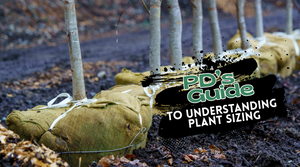Common Pawpaw
Common Pawpaw (Asimina triloba)
Common Pawpaw is a native understory fruit tree with large, tropical-looking leaves and custard-like fruit tasting of banana, mango, and melon; its pyramidal to spreading habit and yellow fall color bring edible interest to woodland edges and sunny edible landscapes.
Distinctive Features
Showy maroon spring flowers are beetle and fly pollinated, followed by clusters of green fruit that ripen late season to soft, aromatic yellow; bold foliage casts dense shade and provides larval food for the zebra swallowtail butterfly.
Growing Conditions
- Sun Exposure: Full sun to partial shade; heaviest fruiting in at least 6 hours of sun.
- Soil: Deep, well-drained, fertile soil with consistent moisture; tolerates loam or sandy loam.
- Water: Keep evenly moist, especially during establishment and fruit swell; avoid prolonged drought.
- USDA Hardiness Zones: 5 to 9.
- Mature Size: Typically 15 to 25 ft tall and 12 to 20 ft wide; may sucker to form colonies.
- Bloom Time: Mid to late spring; fruit ripens late summer to early fall.
- Soil pH: Slightly acidic to neutral, about 5.5 to 7.0.
Ideal Uses
- Focal Point: Bold foliage and unique fruit create an edible statement near patios and paths.
- Edible Landscape: Productive native tree for orchards and mixed food forests.
- Woodland Edge: Thrives with morning sun and afternoon shade under high canopies.
- Wildlife Support: Host plant for zebra swallowtail and fruit for birds and mammals.
Low Maintenance Care
- Watering: Deeply soak when the top 1 to 2 in are dry; mulch to maintain even moisture.
- Pruning: Minimal; remove crossing or crowded branches in late winter and root suckers if single-trunk form is desired.
- Fertilizing: Apply a balanced, slow-release fertilizer in early spring if growth is weak; avoid excess nitrogen.
- Mulching: 2 to 3 in organic mulch over the root zone, kept off the trunk, to cool roots and conserve moisture.
- Notes: Plant at least two different cultivars for cross-pollination and better set; hand pollination can improve yields; protect ripening fruit from wildlife and provide wind protection for young trees with deep taproots.
Why Choose Common Pawpaw?
- Distinctive Flavor: Custard-like fruit with tropical notes.
- Native Resilience: Adapted to regional soils and climates with few serious pests.
- Ornamental Foliage: Large leaves and yellow fall color add texture.
- Ecological Value: Supports native pollinators and butterflies.
Plant in full sun to partial shade with rich, well-drained soil, pair with a second cultivar for fruit, and maintain steady moisture for reliable, flavorful harvests.

OUR SIZING
Not sure what 2 inch B&B or 30 Gallon Clump really means? This guide breaks down all our plant size terms so you know exactly what to expect, whether you're ordering online or picking up at our nursery. From caliper measurements to container volumes, we've decoded our system to help you shop with confidence.

Plant Detectives Shipping Guide
Nationwide plant shipping made easy. Learn how we ship trees, shrubs, annuals and perennials. No order too big or too small. Fast, careful, and contractor-friendly.

